
Accueil > Les rubriques > Cerveau > Lines of split
Lines of split
art today on the threshold of the maze
,
Toutes les versions de cet article : [English] [français]
Ce texte est une conférence prononcée à Suwon, Corée du Sud, dans le cadre du congrès de l’AICA international et publié dans le l’ouvrage paru à cette occasion. Il s’agit dans un même temps d’interroger les formes mêmes des pratiques artistiques en les rapportant aux discours critiques qui les accompagnent et d’appuyer cela sur quelques exemples d’artistes coréens contemporains ayant pour la plupart une expérience directe de la schize orient/occident.

- Paik Nam June
1 - Of the crisis and the in-between two worlds
The issue at stake, both for artists and critics, is to know where one should stand to create and what is important to create today.
There is indeed nothing obvious about this. For two main reasons : the first being that we are living in a world said to be globalised whose order can only be perceived with difficulty and, at any rate, no longer matches the pattern inherited from modernity. The second reason being that we have really lost our bearings. In order to comfort ourselves and in the hope of finding some form of direction or other, we are both constantly in search of roots, looking toward the past and lifted by the hope that something new, a miracle maybe, might help us to do so and then we are looking toward the future.
This situation, therefore this disorientation, is not without impact on the minds of each one of us, and artists in particular.
This disorientation feels uncomfortable. It is the current form of the crisis. In this crisis no one can assert they are living in a single world any more. Each one has to admit they are living in at least two, and actually several. Which enables us to state that our actual situation is one of being permanently "in between".

- Paik Nam June
Crisis, in contrast to what one may think, is a positive word, provided you understand it as defined by the great media philosopher, Vilèm Flusser. In the chapter entitled "Moon" from his book "Essays on nature and culture" he notes that the moon has become a satellite belonging to NASA, whereas we still see it as "a natural satellite of the earth" : my vision doesn’t take my knowledge into account. This lack of reckoning of knowledge in our vision is a feature of certain situations called "crises"."(quoted work. p 62). This remark is very useful to us in so far as it points to the challenge which confronts both thinking and art, and beyond that, all creative processes, which is how to implement, restore or transform the links and connections between knowledge and worldvision. What is being referred to here are the connections between the data provided by hard sciences, such as the human sciences, and the acceptable representation of an equally acceptable world we are trying to form. And the difficulty lies in the fact that the world we are living in is not only tough, violent, and unsteady, but also hard to embrace with a single gaze.
This tension leads us to understand that those obvious things are but old beliefs. We might also call them stereotypes, rooted in us by the particular use we make of language, or we might say languages.
Art is but an individual or collective attempt to understand what is occurring by projecting on to the world what pertains for each in relation to their knowledge and need for direction, and thus art finds itself in a new position. Its primary purpose is no longer to link a plastic, literary or musical proposal to feelings, and to go from the psycho-emotional field towards beauty or even truth or towards the intellectual field.
Art is nowadays entirely devoted to this demanding yet lofty task of translating what is little or ill-known into a more familiar vocabulary, or, if you will, to lead the familiar forms of language or expression to some renewal, so as to be able to face that upcoming unknown.
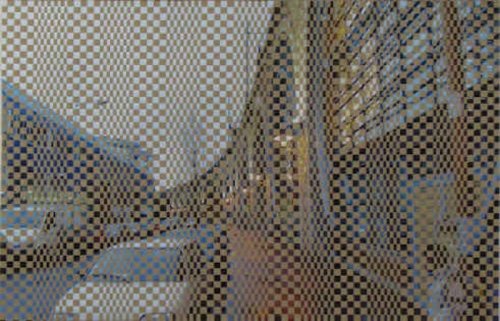
- Chong Jae-Kyoo
One could mention the major visionary and anticipatory work by Nam June Paik, and more particularly "Moon is the oldest TV".
This image of the moon is actually a lit up surface. It is easy to see some barely metaphorical connection to a projection. The surface of the moon immerses us into some expectation of an image which would be projected over a kind of screen suspended in the infinite darkness of the sky, like in a huge cinema hall. For Paik, the Moon is thus the "oldest TV". The Moon has always been there, or nearly. However, we also know that Paik goes further in his refusal of the different features attached to the medium of TV - live broadcasting, recording, rerun, permanent flow of all kinds of images - since the so-called phases of the moon do not actually exist. The forms we take for moon crescents in his work have actually been obtained by placing magnets on the cathode-ray tube. The image of the moon is generated by our association process, our infering system. The image on the screen is clearly born from our imagination, even though it is based on a phenomenon linked to the medium of TV. Television then becomes the transcription into our world of an original shape which existed long before man could look at it as a natural phenomenon, an image, or as a NASA satellite.
We should call forth, as an echo, Jean-Luc Godard’s latest film, whose title is in itself a very ambitious yet very ambiguous scheme, "Farewell to Language". He is indeed pointing to the obstacles, unyielding areas, frictional areas between words and images, which can sometimes be spotted in the shape of tiny black holes or unexpected electric flashes of lightning.
A map appears which enables us to classify practices and artists according to criteria which are to be invented or reinvented. Those criteria need to be based on those different "translation modes" seemingly on trial, and on the type of areas they enable us to perceive.
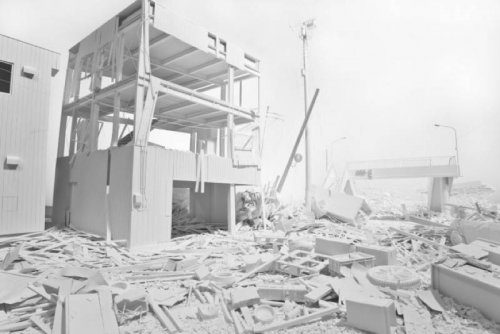
- Ha Tae-Bun
We have to understand that the new, this guardian spirit of modernity and its post-modern avatars, is no longer the ultimate referent of these asssessments. Let’s call to mind the last lines of Charles Beaudelaire’s great poetry corpus, ‘Flowers of Evil’, situated at the end of the last poem called ‘The Voyage’ :
O Death, old Captain, it is time. Weigh anchor !
To sail beyond the doldrums of our days.
Though black as pitch the sea and sky, we hanker
For space ; you know our hearts are full of rays.
Pour us your poison to revive our soul !
It cheers the burning quest that we pursue,
Careless if Hell or Heaven be our goal,
Beyond the known world to seek out the New !
(translated by Roy Campbell, Pantheon Books, 1952)
What we have to do today is invent new criteria corresponding to new areas on the map of practices. Throughout the 20th century we have forsaken beauty. We have also forsaken, with the new, its corresponding subject and therefore the emblematic figure of judgement.
For some, I am referring to artists, creation will be an attempt to oppose this tearing apart of a jeopardised world vision and knowledge gone out of control, by acting as menders, so as to salvage what is left of this ancient vision of things. With knowledge spiralling out of control, and with the metamorphosis of our world vision, the purpose is to protect and comfort ourselves, as well as all those who think along the lines of the ancient world, or at least of ancient languages and modes of expression. These artists stand between two worlds, as between two landmarks liable to be squashed or passed over. Their importance lies in their function as markers and witnesses, and in their ability to nevertheless allow the minds of some to capture the malaise. These artists think of art as stemming from art.
For other artists, art is the means by which they endeavour to understand what comes about the world. Their practice is totally located in the in-between. They have understood that inventing is translating. These sheer translators, in so far as their approach is not too faulty, are facing a major problem : in a world dominated by technical and electronic rationality, they have to bring into being states, forces and shapes which have to do, in common language, with non-rational and non-ratioanlist entities. They have to articulate together the powerful impulses of hypertechnicality and minds which are inclined to translating into a language the signs from worlds that are operating secretly. They are the true intercessors, the true shamans, the true inventors, in so far as they endeavour to translate what spirits have to say about what is coming from the uncertain language of in-between worlds.
So nowadays art stands as a subtle interstellar probe enabling us to analyse the world, the universe, the cosmos, the infinitesimally small, the physical world, mental worlds, and project back in a necessarily fearful and wary present what research has not always managed to grasp.
It is inevitable that this understanding will be imperfect. We need to accept this imperfection. That is why art can no longer set for itself beauty as a goal. It has to aim at shapes whose function is to be links, bridges, translating devices, direct connections between earth and sky, between dream and reality.
This map, once it has been sketched, makes it possible to draw another map, that of the new functions of critique.

- Ha Tae-Bun
2 - The maze and multiplication of the lines of splitting
The Argentinian writer Jose Luis Borges noted that the most radical shape of the maze was the straight line. Close your eyes and try for a minute to picture the formidable order it represents, and the trap it is for the mind : the straight line, that of the road leading straight to the point, that of time supposed to lead straight to death or resurrection. And suddenly this form of pure plastic expression of reason becomes a source of questions generating distress. What is the straight line but the paradoxically closed form of the in-between ? It asserts the connection, yet loses all contact with the worlds at each end of it.
Art is not opposed to reason. Its most inventive representatives are those who can and will question our belief in reason and its almighty order, turning life into a route stretching from one point to another.
The subject is the mental form able to obey that order.
Art has long been borne by the need to partake in this celebration. Things have changed nowadays. The challenge is to understand what we have lost by settling on the straight line like on our own territory and our own dwelling. We need to accept the fact that the straight line has become the shape of the in-betweenn in order to both get closer to the lost and get closer to what is coming. Then the signs, noises and the most diverse expressions can reach us again, since they will be perceived by us. And we discover once again that there are countless worlds in us and around us.
The maze has thus changed shape. That is why we are under the impression that we are twice lost.
The first time, because the straight line no longer meets our expectations, no longer conveys them towards the idea that we are borne by a goal, and that an end is awaiting us. That is why we have become "foiled men". We have turned art into the exploration track of our disillusionment and have learnt to judge artists in connection with the relation we have to this disillusionment.
The second time, because we obstinately close our eyes on the masses of data reaching us from everywhere because we think they are going to drown us, and also because we believe we haven’t got the means to classify them.
Critique today has to be a textual production-field taking into account the new power of images, and which finds and invents new ways to think them with words. Critique today is in charge of this language which seem to elude us as much as we elude it, of images which make it think they can do without it and of this in-between, this new existential situation from which it has to think.
We will call this in-between, the split. It is projected and spreads from the outside, from our relation to the world, towards what used to be our inwardness, and turns it inside out, the way you would a glove. Therefore the stand of the enunciating subject doubles our relation to the world. The in-between is both a sign of the crisis and the shape of the split. The splits runs through the world and restructures it, as it runs through us and restructures our position in the world, as well as our psyche.
The straight line is the shape of the maze when it aims at a goal, but it becomes a line that traverses and splits, a line of split when it runs through it all, leaving white trails in the areas of practices and thought, like the vapour trails of planes in the sky.
The maze was the line, invisible yet perceptible, splitting in two the world between the world of images and the world of words, yet linking them and suggesting that this line led somewhere. Nowadays the maze is this gap "space", traversed by temporary or permanent lines, like so many dividing lines or split lines separating what used to be thought of as united. If we agree to duly note this new deal, our relation to the others, to the world and to ourselves needs to be reformulated.
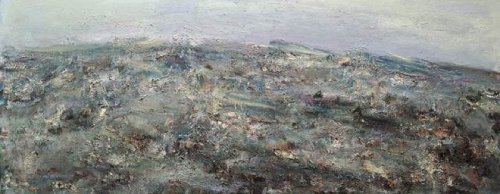
- Kwun Sun-Cheol
The split is to be understood in a positive way, freed from any psychiatric meaning. The split is the state of our brain today, the state of our divided thought, in the same way as the world is divided. We therefore need to invent a new way of conceiving and pondering over what is happening, and what is happening to us. The split is both a source of tension and the central form of invention.
Critique has to take charge of the crisis as a manifestation of the split, and as for art, it has to take charge of the split as an expression of the crisis. Art multiplies the lines of splitting while critique spots them and tries to give them, if not some order, at least a shape, a figure, a readability, hinging affects on percepts.
This positive approach of the split leads us to understand that it no longer manifests itself as a deep fracture between two irreconciliable worlds but as a network of cracks. The split doesn’t grow, it multiplies. In other words the split is the hallmark of the multiple in a still "monotheistic" world.

- Lee Ufan
3 - The East/West split, art forms, and the role of critique
Whatever we are, a shaman or a Christian, a Buddhist or a Muslim, a rationalist or a mad scientist, a techie or a technophobe, worried about the self-inflicted death of mankind, or wishing to do our utmost to head for a still possible happiness in spite of doubts and negations, we can close our eyes and try to flee to an inner world which is so porous that we are barely sheltered, or we can live with eyes wide open by accepting our in-between situation.
We have called this in-between ‘crisis’ - our gaze upon the world and available knowledge, splitting the in-between, seen from the point of view of the psychological field . We shall call the in-between seen from the area of artistic practices, the ‘divide’.
The essential task for artists today is to spot the fractures and articulate them together following principles of resonance, analogy and opposition, and also to try to invent new forms of thinking. For thinking is doing and undoing knots, linking and unlinking, bridging and unbridging. In short, transposing elements from one world into another. In other words, translating or, if you will, in the most essential meaning of the word, metaphorising.
The purpose is not so much to go from one world to another, as in doing so to account not only for difference and resemblances, but also for the additional methods and articulations connected to the retroacting effects of one of these worlds on another, no matter how uncertain the boundaries are. The link, as well as the metaphorical fracture, are just as real when we can feel them run through us and tear us apart.
The core of the last part of my reflection stems from my first hand experience of the practices of Korean artists, My humble efforts to try to understand how the situation of art in Korea is both crossed and borne by some of these "lines of splitting" and how these cracks are a source of radical inventiveness.

- Natacha Nisic
As a pattern of reference, European art, together with American art, is a cultural object, a symbol and a source of "fantasies", and therefore a kind of energy battery with a variable intensity, but always working. However, for a good thirty years, a powerful Asian cultural influence has been rising, as the American cultural influence and the European influence as well have been declining. This, for us today, is one of those major lines of splitting that runs through the world in all directions.
To put it in a nutshell, following that line of spliting is travelling, and it can only be done in a new and unexpected way, for the terms of the travel are new and unexpected. Samuel Beckett’s famous quotation will be remembered at this stage : "we don’t travel, as far as I know, for the pleasure of travelling, we are dumb, but not that dumb".
In her notebook from the "Memoirs of Hadrian", Marguerite Yourcenar notes a quotation from Flaubert’s ‘Correspondence’ : "Just when the gods had ceased to be, and the Christ had not yet come, there was a unique moment in history, between Cicero and Marcus Aurelius, when man stood alone." One can say that that moment was "a vacuum filled with man".
We ought to analyse this sentence again today, and reformulate it to say that now the gods, having ceased to be, and man, to a great extent, having started to vanish on the horizon of fear, what is left for us is only to travel in the in-between, since it is the shape of the world reflected by our minds, and the shape of our minds turning into a branching world. And oddly enough, what we find again is a face to face encounter between the forces of the non- rationalistic, which leads us to rethink how we deal with magic and the forces which carry out man’s effacement amid the reckoning of some hyper rationalisation.
One may also say that in both cases, the point is to pull to one side or the other so as to lift or put down, or in any case, connect the dream’s skirt to the skin of the real.
It is all about permanently crossing over the line of splitting. Some devote their lives to creating links and measuring distances between the two sides of a line, others like incorrigible wanderers travel so many lines that they draw maps of the world of a wild intricacy.

- Chong Jae-Kyoo
Over more than twenty five years I have met a great number of Korean artists who have come to settle in France. I was also lucky enough to regularly and frequently stay in Korea over the past ten years. I have therefore been able to see that there are three major ways for Korean artists to let the East/West line of splitting run through them.
1. As an art critic, as a friend, as a philosopher and writer too, I have tried to understand the "reasons" which prompted Korean artists to come and settle in France after their country opened up at the end of the eighties. For the youngest, a tuition free, good quality educational system was obviously the incentive, but for all, the main incentive was the aura of "Paris, the capital of the 19th century" as Walter Benjamin, the German thinker would name it. This aura kept shining intensely till the late sixties, and is still beaming today. In other words, Europe, and France in particular, enjoyed, and are still enjoying, a huge symbolic and dreamlike power, with Paris as its living heart.
When one discovers later on how intense the attachment of Korean people to their homeland is, going away, leaving Korea, seems like a strong move, a rending move, and one ends up guessing that they are inevitably haunted by some sort of pain. However, we have to take into account and understand the power of attraction of the West, even today, in what obviously matters the most, i.e. their longing for spiritual openness. Furthermore, at a time when globalisation was starting, there was a pressing need for a deep knowledge of Western culture. From a global point of view, it was important for this country, just out of a fratricidal war and beginning to take its place in the community of industrious nations, to forward envoys so as to better understand the foundations of European culture. From an individual point of view, each artist became an "experimental laboratory", per se. Each and everyone was about to experiment at the same time, for themselves and for the others, both the difficulties inherent in cultural différences, and the potential forms of getting closer and even creating a link.
Park Ynhui’s text (Park Yeemun’s pen name) is now available with the ‘Ateliers des cahiers,’ translated by Benjamin Joineau and is entitled Don’ listen to a pig’s voice.
It bears single-handedly all the tensions and the violence inherent in the trip to the West and in living in a neighbourhood when one has settled for a few years.
2. I have also met in Korea artists who had not necessarily stayed abroad but who were both filled with analysis from the West and deeply rooted in their own culture. I have therefore been able to grasp how that culture was itself torn apart , and therefore split, between some hypermodernity experienced in their daily lives, but that was quite missing in art forms, and some classicism, as far as the conception of art is concerned, whose purpose is to mitigate these inner, intimate and psychological tensions often generated by being subjected to technical progress.
3. Finally, I have discovered artists for whom this fracture is no longer relevant. Another one matters, separating and linking the cosmic expectations of an ongoing metamorphosis. It is difficult to account for it in traditional language, or if you will, in the language and classical forms of art.

- Natacha Nisic
But what matters above all is the fact that, in most cases, Korean artists are confronted with two of the lines of splitting, and more often three, in different proportions however.
I leave it to you to use your critical sense, according to the meaning I try to give the word. I will briefly mention the Korean artists I have written about, without classifying them in one of these categories or another. They seem to make it possible to draw up a complex map of the lines of split deriving from the great East/West fracture. My list will not obey any ranking by age or type of artistic practice but will endeavour to show how these lines work together.
Chong Jae-Kyoo is obviously one of the most forceful artist, but also one of the lesser known when it comes to the lines of splitting. Nothing better than his work can express, in the field of plastic arts, what was seen to emerge through Park Ynhui’s remarks, namely that the difference between East and West is actually a confrontation between both the fascination that reason exerts on the minds of men, as well as on the new face of the world and a relation to the world which has not forgotten its old foundation, its intimate relation to tradition and to nature.
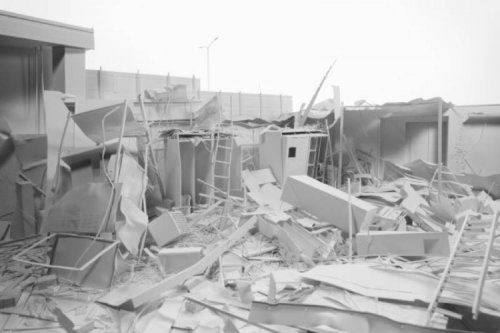
- Ha Tae-Bun
Korean artists bring forth a renewal of artistic practices through their experience of the journey precisely because they hinge this obvious omnipotence of reason on the never ending power of affects which are rooted in a magical approach to the world, of cultural affects which are nevertheless truly experienced.
Kwun Suncheol is a painter who has been living in Paris for decades but who keeps going back and forth between France and Korea. His work stems from the Korean tradition of landscape painting. However we can discover in his paintings how violent his painting technique is. His brush strokes are so powerful that they torture the backdrop and express the torments of minds. Thanks to an expert technique, he turns the portraits he makes into genuine landscapes. In his work you can also perceive barbed wires reminding us of the Korean civil war as much as the camps that Europe knew around the First World War. As Park Yhnui showed, what is at the core of the work of numerous artists who have a strong connection with the West is the dialectics between cultural roots and the absorbtion of the other’s culture.
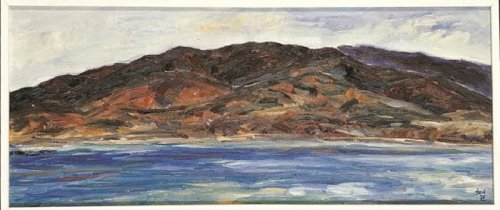
- Kwun Sun-Cheol
Other artists like the famous Lee U Fan achieved another scenario, i.e. imprinting the West with the mighty presence of the East through the recognition of their work. His brush strokes are close to those performed by abstract lyrical painters and he has produced works which stage the hinging of the full on the empty. He has managed to impose a brush stroke which bears in itself the whole of painting gathered in the gesture that performs it. His work, like an active meditation, is a kind of presentification of the split in which the East wraps up in its translucent veil the outcrops of western thought. The same can be said about the work of Bang Hai-Ja who has lived in France since the sixties, and who seeds the western mind with a vision of the cosmos imbued with wisdom.
A more complex and more diffuse approach finally appears in a somewhat younger generation, in which one can see Nam June Paik’s still unaccepted legacy and the demand for a speech exploring the multiplicity of splits rather than that the huge fracture between the East and the West. The great artist Lee Bul has obviously been the figurehead of this movement, resuming a questioning of technology and the mutations that it carries with it. She did so from a strong social and political criticism stand which drove her towards works in which fiction is arrayed from science-fiction to political fiction and impossible narrative. Her works unfold along those lines of splitting averse to narration, and she endows them with a power of significance both organised and not directly narrative.
Younger artists such as Jeawoo or Ha Taebum, for instance, take the use of technology for granted. They have more particularly become aware of the fact that images are the main vectors of this proliferation of splits. As a consequence they legitimately focus their work on a questioning on the status of images today, of all kinds of images, and they not only do so on the world around them but also on the minds which perceive them, consume them or are subjected to them. They do so with visually powerful and emotionally intense works.
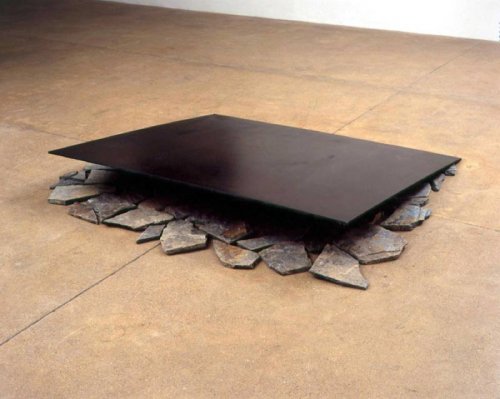
- Lee Ufan
Yet it is important to mention now a new layer of reality and exchanges, a new line of splitting which has become visible for a few years now,, and which is the fruit of exchanges the other way, from the West to the East, through the interest for and presence in Korea of European artists, French in particular. They are attracted by the country, its more contemporary features, but also by its traditions. I will only mention two artists, two women, who stayed here. Each one has tried to approach those two features which fascinate foreigners the most, namely the partition of Korea in two, a truly tangible line of split, still burning in the heart of each Korean, coming from history but still active in their daily lives, and shamanism, that unspeakable presence in the mind of each of those previous worlds ; those other worlds which can be understood thanks to this part in us which connects us to the magical. It has also begun to be contemplated from the point of view of quantic physics, confirming the potential existence of countless parallel worlds called multivers.
I wrote a text about Christine Laquet, for instance, who experienced this by working with a shaman, when she was staying with the GCC. Natacha Nisic showed, in her recent exhibition at the Musee du Jeu de Paume, a long video called ‘Andrea in conversation’ which showed the real journey toward shamanism of a German woman, i.e. her actually becoming a shaman.
Just those two examples show that one can travel along those lines of split and how an artistic production can find there a new opportunity to define itself.
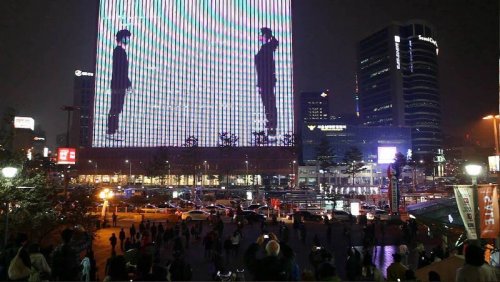
- Oh Jaewoo
To conclude
We are at the core of the maze, and paradoxically, are standing on its threshold at the same time. We therefore have three options, each one being like three modalities of belief. The first one is to keep wandering, arguing of the fact that we can’t find the exit of the maze. The second one is to consider the threshold as an opportunity, and to assume that, whatever our choice, we shall enter a maze of fears and passions or a maze of bare anxiety in front of the huge landscape which hasn’t been designed by the hand of man. The third solution is to assume that the maze does not exist because life is both its name and its shape.
In that case, we can again devise categories, work with them, make them work for us, but also blur them so that we can carry on with our motionless travel into the intricacy of the lines of split without getting edgy over any ideological stand whose function is only now to make us suffer for no reason at all or to perpetuate our subjection to the belief in the existence of the maze.
We have understood that art finds its highest function here, i.e. releasing us from beliefs by performing them and that critique regains its grandeur by deciphering those signs which the thought acting in art has emitted. It gives them an existence in the extended field of the verb, without falling into the trap of forcing them into the pseudo-logical succession of some thoughtless narrative. Words and images then become the two vectors of a living and viral approach of the split, seen as a cross-disciplinary phenomenon and as the name of the divide in the renewed forms of creation.
English Christine Lenormand
